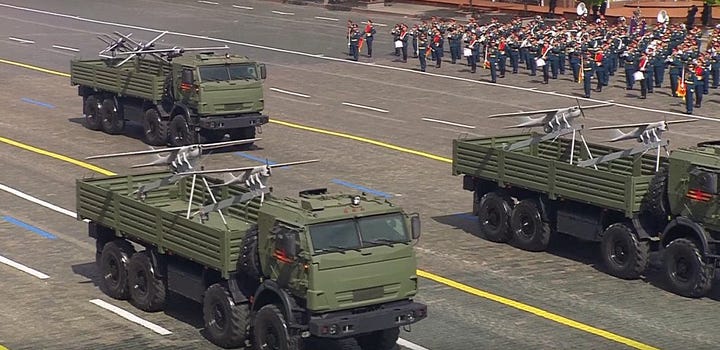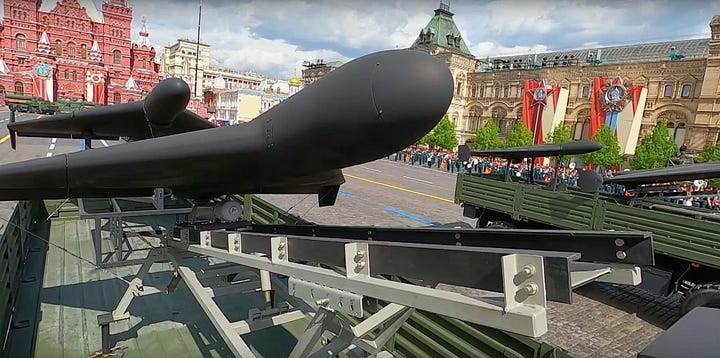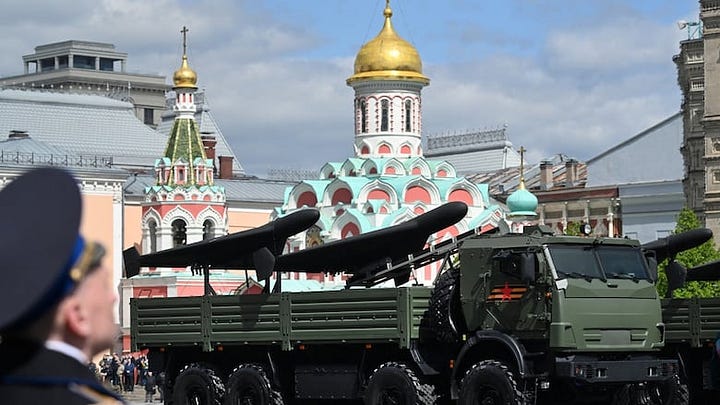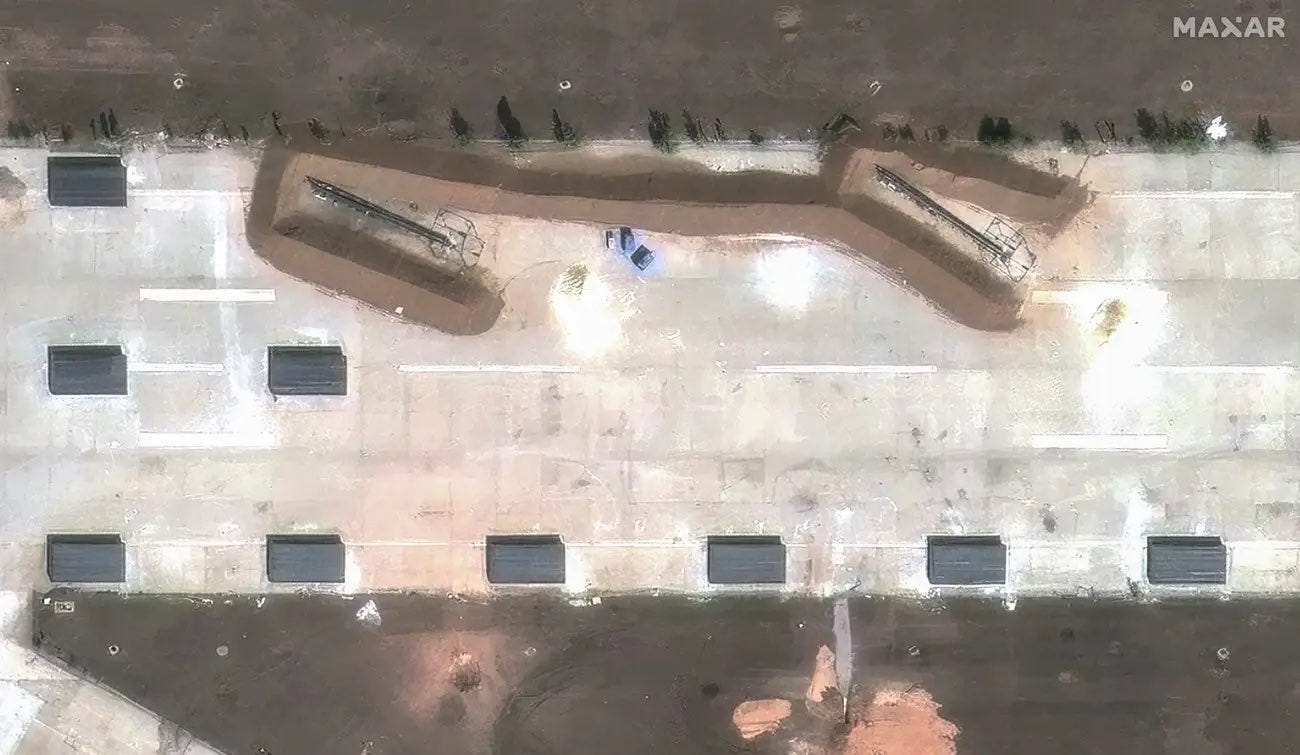More On Russia's Employment Of The Shahed-136/Geran-2/Garpiya As A Battlefield Strike Munition, Loitering Strike Drone
🇷🇺 🇺🇦
Note: The following text was originally posted on my X/Twitter account. This post greatly expands on several of my recent posts including the following:
Russia Adapts Shahed-136 Into Battlefield Strike Munition, Loitering Strike Drone
Note: The following text was originally posted on my X/Twitter account.
The Shahed-136/Geran-2/Garpiya catapult-type launchers at Donetsk Airport, which is now located some 36 kilometers from the frontlines, may be associated with the still fairly new 7th Separate Regiment of Russia's Unmanned Systems Troops. This regiment operates a mix of fixed-wing ISR drones (Orlan-10, Orlan-30, ZALA, etc.), Lancet family fixed-wing loitering strike drones (both the larger and longer-range Izdeliye-51 and the much smaller Izdeliye-52), as well as both the Geran-2 and Garpiya fixed-wing strike drones. This peculiar array of fixed-wing drones of highly variant maximum range-payload is likely intended to undertake strikes against fairly proximate battlefield targets located at a distance of up to 50 or so kilometers from the frontlines/international border.
There exists a steadily growing library of documented attacks involving Shahed-136/Geran-2/Garpiya strike drones against stationary battlefield targets. Such footage is notably not limited to the actively contested Pokrovsk sector, which is near Donetsk city and its nearby airport. There are multiple documented cases of Shahed-136/Geran-2/Garpiya strike drones being used to attack fairly proximate battlefield targets in the Sumy sector. It is important to note that the Geran-2 is available in a reduced-range configuration that is equipped with a 90-kilogram warhead, which is comparable in terms of weight to the warhead found on the 227 mm GMLRS artillery rockets used with the American tracked M270 MLRS and wheeled M142 HIMARS systems. The Garpiya, which is built at a different production line in Izhevsk, Udmurtia, than the Geran-2, which is built at Alabuga, Tatarstan, has recently been seen in a reduced range configuration that is equipped with two 50-kilogram warheads.




While these heavier warhead configurations are also being used by Russian Army Shahed-136/Geran-2/Garpiya launch units to attack targets (within range) across Ukraine, Russia may be concurrently using some of its Shahed-136/Geran-2/Garpiya strike drones to serve as lower-cost—but also lower penetration rate and longer time-to-target—surrogates for medium 227 mm diameter and large 300 mm diameter caliber guided artillery rockets/missiles such the 300 mm Tornado-S, which do not appear to be available in the required numbers despite over three years of wartime industrial mobilization. It is important to note that Russia is now employing versions of the Shahed-136/Geran-2/Garpiya that are equipped with an onboard sensor/camera as well as a modem/radio frequency datalink to facilitate (line-of-sight) human-in-the-loop supervision, if not control, over these strike drones. While such an operating concept is not practical for use in attacks against targets located deep inside Ukrainian-controlled territory in the absence of readily available low-latency and high-bandwidth beyond-line-of-sight satellite communications, it is practical for use against fairly proximate battlefield targets located within 50 or so kilometers of the frontlines/international border, not least at a time when aerial radio relays/repeaters are in widespread use to extend the maximum practical range of armed multirotor drones, fixed-wing ISR drones, and fixed-wing loitering strike drones like the Lancet family.
According to a Ukrainian media report from May 2025, which claims to draw upon leaked Russian documents, the 7th Separate Regiment of Russia's Unmanned Systems Troops has a reported target strength of around 1350 personnel and is reportedly composed of one strike drone battalion and three reconnaissance drone battalions. The regiment is reported to have a target force structure of 102 drone crews, of which 41 will be strike drone crews and 61 will be reconnaissance drone crews. According to the Ukrainian media report, the total of 102 drone crews which are to constitute the 7th Separate Regiment is composed of 61 crews operating various ISR drones, 33 crews operating Lancet family loitering strike drones, six crews operating Kub series loitering strike drones, and, not least, two crews operating the far larger, heavier, and longer-ranged Shahed-136/Geran-2/Garpiya strike drones. Two large catapult-type launchers compatible with the Shahed-136/Geran-2/Garpiya have notably been seen at Donetsk airport (image 1).
While the 7th Separate Regiment of Russia's Unmanned Systems Troops may be operating from Donetsk Airport, it is important to note that there are now several enterprising Russian drone units. The most notable examples include Russia's Rubicon Center, which is a known operator of Lancet family loitering strike drones and appears to now also be involved with uncrewed surface vehicles (USVs) alongside its core capability set, which concerns the employment of armed "FPV" multirotor drones. There is also the enterprising Bars-Sarmat unit, among others. It is unclear whether these units will also begin to operate Shahed-136/Geran-2/Garpiya strike drones to attack fairly proximate battlefield targets with either a 50-kilogram or 90-kilogram warhead that dwarfs the warheads installed on all their other munitions.



